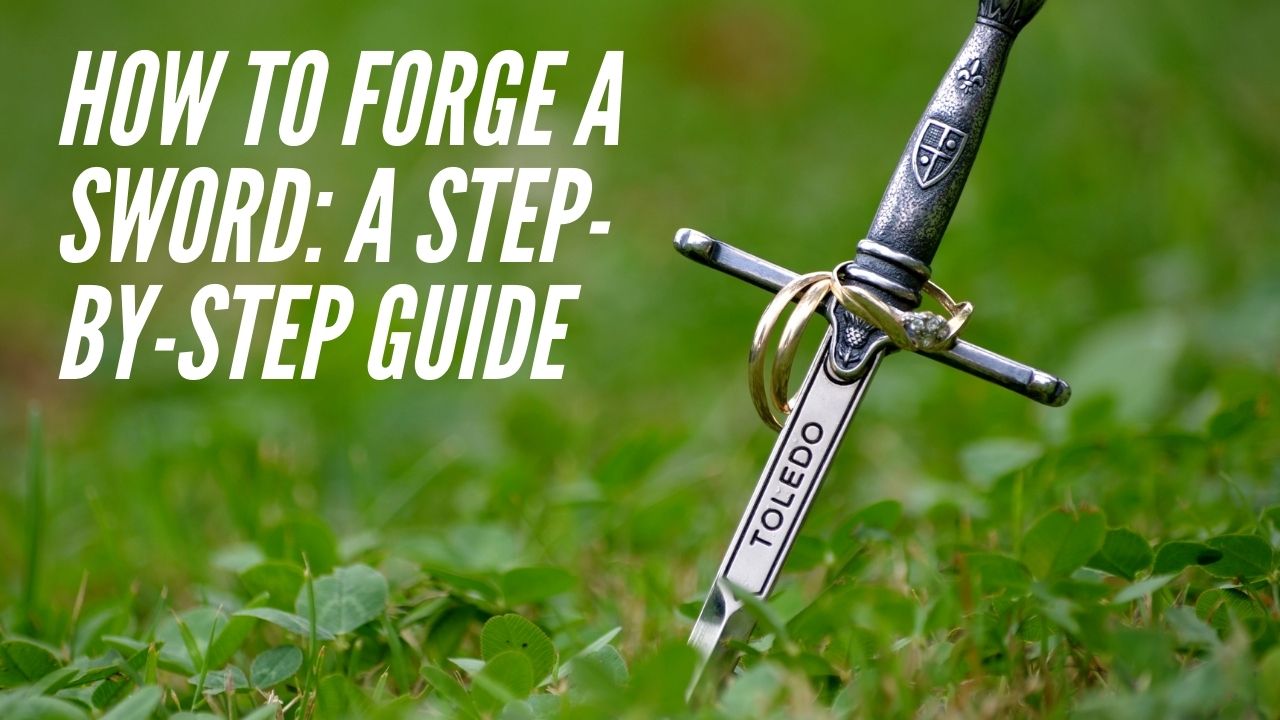Introduction
Do you want to take your forging skills a step higher? Try forging a sword! It is one of the most convenient points to start if you want to learn how to forge weapons. There is absolutely no big deal in making your own sword once you know the right steps to follow.
Sword making is one of the oldest blacksmithing skills. The urge to forge other weapons is one of the propellants of modern-day blacksmithing. From the historical records of blacksmithing, the need to forge stronger and durable weapons fueled the need to forge swords.
Looking at the historical records, sword making is the work of some specific set of people. These people are called swordsmiths or bladesmiths. These bladesmiths or swordsmiths are metalworkers that are specialized and knowledgeable about how to make a sword.
Swords were one of the primary essentials for survival. It was useful as self-defense, as well as hunting prey for food. However, the relevance of swords is still preserved till today. Blacksmithing sword is not different from the ancient swords.
As much as forging a sword is not very complicated, it is not so easy as well. Before you embark on the journey of sword making, ensure that you have acquired the necessary skills and you have the right materials. Also, ensure that you already have an imaginative picture of the type of blade you want to create.
Having an imaginative picture of what you intend to create before forging swords will not only help your creativity; it will also help in making the entire process more precise and less complicated. It will also help you to decide the appropriate material to use for the project.
Note
Like most processes in blacksmithing, forging a sword requires patience, loads of practice and a lot of trial and error. Yes, it looks straightforward in movies, but it’s a bit more complicated than that in real life, and it takes a lot harder work than what we see in movies.
However, with the availability of the necessary skills, right materials and tools, you can be sure of creating or forging the blade or sword that you desire. The process may seem complicated for some, but it will become relatively easy for you if you follow the right guide.
Now, let’s get down to the real deal!
Brief Overview
Before we dive into the full guide on how to forge a sword, let us know the right materials and tools that are needed. This knowledge is essential because the type of materials you use can be highly influential on the overall outcome of your sword making process.
Likewise, the materials employed in the art can also affect the quality and the effectiveness of the sword. Similarly, using the right tools for the process will help you to ease the process of making a sword. Also, it will help you handle the process of mastering the skills of sword making. This article will guide you through the process of forging a sword step by step even if you don’t have prior experience of sword making. It will also help you on how to forge a sword at home.
The materials and tools essential for the sword making process are not very different from the general blacksmithing tools and materials. Although the tools can be broad, the materials can vary. This variation is usually dependent on the choice of the blacksmith and the type of sword or blade that he intends to create.
The tools that are needed for the sword forging process included in the “Essentials”.
Each of these tools has a specific purpose in the process. The various grinders and cutting torch are the shaping tools that will help you in giving your desired shape to the sword.
The sandpapers, mills, and steel grinders are specific for the finishing process. The utility knife is particular for woodwork, particularly on the sword handle. However, it is essential only to make use of tools that you are familiar with in blacksmithing.
Quick Note
These materials are dependent on the preference of the blacksmith. The common materials for making sword include copper, steel, bronze and iron.
Now that we understand the essential materials and tools for the sword making process, let’s get down to the real deal!
Instructions
Step 1: Prepare Your Materials and Forge
Several features are commonly looked out for in swords to decide the extent of its quality. The four significant features are strength, balance, flexibility and hardness. It is, however, easy to achieve these qualities if you have the right materials, and you follow the appropriate steps. Now that you are aware about the essential materials for the process, it is best to get them ready before you proceed. Likewise, no forging process can proceed without a forge. You should also take your time to prepare your forge and be sure that you are ready.
Step 2: Heating
You can start your forging process once you are done preparing your forge. Setting up a forge is important because for other processes to take place, you need to heat the metal stock to a workable temperature. You can choose from the available forge options; it could be a coal forge or a DIY propane forge.
- Before you proceed with the heating, make sure you have cut the metal you want to use to the desired length.
- If need be, you should also consider working on the width of the metal. The major determinant of the final output is the sword style you want to create.
- Now take a bar of your desired metal(s) and heat it in the sword forge.
- You should leave the metal in the forge until you have a yellow heat.
Step 3: Hammering
After it is heated up, you begin the hammering process, which may take a reasonable period due to the need for sectional hammering; hammer repeatedly, re-heat, and repeat the process till the sword takes your desired shape.
The hammering process is one of the major determinants of your sword’s dimension. You can also take advantage of the hammering process to work on the width, length, and thickness of the sword blade.
The hammering process might be strenuous, but you need to do it carefully. Always remember that in most cases, hammering requires more technique than power. After the hammering process, you can heat the sword and allow cooling.
Step 4: Annealing
Annealing is a relatively easy step. This part involves preparing the sword to be worked on by different tools. The major reason for annealing is to soften up the metal after all the forging. This process is done by heating the sword – until it loses all magnetic attraction – and allowing it to cool very slowly.
Heating is a fairly simple process, but slow and even cooling can be complex. You cover the sword in an insulator, which will slow down cooling. Or you can take the sword and bury it in the sand.
The cooling process can take the whole day. The annealing process is one of the major sword making steps that transform the sword from ordinary metal to an amazing weapon. This transformation is made possible because it gives room for other processes to be effectively carried out.
In summary, annealing involves heating to an extremely high temperature and allowing it to cool down as slowly as possible.
Step 5: Grinding
This part involves a lot of work because it is another decisive step in this process. This step is carried out after achieving a uniform thickness in the sword’s length. With this step, you will create the sword’s edge and point. The following processes will help you achieve better results;
- A good idea will be to start with big power tools. If you have a 6” belt sander, start with it as it will do most of the work for you.
- Afterwards, you can use a 1” belt sander to file. This whole process will take around 3-7 hours, depending on the size of your sword.
- You should also ensure that all the slags on the surface of your metal are eradicated before proceeding with the grinding process.
However, the form and shape the blade will take can be dependent on the type of grind you use. There are three types of grinds. These grinds include convex, concave, and flat grinds.
Concave type of grind will give you a blade with an inward curve tending toward the cutting side. Flat grinds, on the other hand, are quite simpler. It follows a plain level with equal angle across the surface of the sword. The convex grind is unique on its own. It has a smooth, rounded edge with a higher amount of strength.
Quick Note
Note that you can make the whole process a lot easier for yourself by first marking out the way you want the sword to look like, including the size and shape. You should also be careful while working with the grinder so as not to make the blade of the sword tinier than originally planned.
It is also at this point that you can add any engravings or designs. At this point, plus the designs, you will start having the shape and form of a sword. This step is quite flexible and you can showcase your creativity at this step.
Step 6: Hardening
Also regarded as heat treatment, the hardening process in sword making is important to make a sword suitable for its purpose. At this point, the sword is still very soft as a result of the annealing process and needs to be hardened. The hardening process can be unique for the type of steel you are using, but you can employ a more general method.
- You can proceed by heating the sword to the point of austenitization. The appropriate level of temperature that the metal must reach is dependent on the type of metal you are using.
- As soon as the blade is removed from the forge, you must immediately place it into a quench tank. Placing in the quench tank allows the blade to cool evenly and quickly.
Nevertheless, you should ensure you are only heating the piece to the appropriate temperature. To ensure that you are not overheating the metal, do not heat it in a drastic manner. You can begin with a lower temperature before raising it gradually till you achieve your desired temperature. The mechanism of this hardening process is quite simple.
Quenching the heated metal rapidly locks the available carbon molecules to form a network of a closely packed lattice. The blade needs to cool evenly to prevent warps or fractures. This entire process hardens the metal and makes the metal worthy of being called a sword.
Step 7: Tempering
This step is important and it comes after the hardening process. The steel is very brittle and can shatter or crack if used to strike an object, at this point, therefore it needs to be given some flexibility. Tempering will bring about the much-desired flexibility to your sword.
- This process involves heating and monitoring the color of steel. You want the edges to be a wheat color (not too soft) and a plum color for the centerline of the sword (soft enough for soft flexibility and durability).
- Pay close attention to the color change of the steel to keep tab on the temperature change
- Remove the sword from the forge immediately it reaches the suitable temperature
- Quench rapidly afterwards
- Clean with a coarse Emory paper to give it a smooth and shiny surface.
Step 8: Final Grinding, Polishing and Completion
Now it’s time to grind, grind, grind until you are satisfied with the outcome. This process will add the final touches to your sword to make it durable, classy, visually appealing. You might want to use different grits, but start from around 220 and work your way up to 600.
This step will give your sword a nice and polished look. If you want it even shinier, you can continue with finer grinds or use a polishing wheel. You should also add your preferred handle and other designs at this stage. You can also make use of a lethal wrap for the handle to help its efficiency and durability.
Also, this step is also flexible; you can be as creative as you want.
Viola! Your sword blade is complete. Now you can add the additional parts like the pommel, the guard and the hilt. The above steps will help you answer basic questions about how to smith a sword.
FAQs to Forge A Sword
Question
How long does it take to forge a sword?
The time it takes to forge a sword varies due to several reasons such as; how professional the blacksmith is and its crookedness. In either case, it will take about 2 to 5 days to know how to forge a sword step by step. It might take you about a week to make a fancy sword and lesser if you are an experienced blacksmith.
Question
How to make a sword without a forge?
To make a sword without a forge, you have to get a metal plate and mark your sword’s shape on it with a marker. After marking the shape, you should cut it out of the metal so that you have the handle and blade of the sword.
Sharpen the edge with a belt grinder and then make three holes at the end of the blade reserved for the handle. Get two shaped flat blocks of wood and attach them to the blade through the hole created. Your sword is ready.
Question
How to make a sword handle?
There are different ways to make a sword handle, depending on the design the sword takes. To make a simple handle without a hilt, you have to cut out the handle’s shape from the blade using a grinder. After cutting out the shape, drill holes into the blade with a drill press; these holes will serve as a means of fastening the handle to the sword.
Get wood and cut out the shape of the blade handle. Drill holes into the wood and make sure the hole aligns with those on the blade. Get a fastener to join the woods and the sword together.
Question
What is the best metal to make a sword?
There are various metals to make a sword, but the best is steel. You can use carbon steel or alloy steel as they have high resistance to heat and corrosion. You can also use stainless steel, tool steel, and other alloys to make a sword.
Question
How much iron does it take to make a sword?
On average, a finished sword weighs about 1.5kg. During the process of forging, there is the generation of waste that weighs about 0.75kg. Altogether, you will need about 2.25kg of iron to make yourself a sword. The larger the blade, the more iron you will need to forge it.
Question
How to make a sword hilt?
The sword hilt is the sword’s component that runs across the blade, causing a demarcation between the blade and the handle. To forge the sword hilt, you will need to get a small metal block or wood, depending on what you prefer. Cut the block to shape and drill the center so that it will enter the sword from the handle end and won’t be able to run along the blade.
After drilling the hole, insert the hilt into the blade and make it fit. Now, you have your hilt on the sword.
Question
When does a knife become a sword?
The primary difference between a knife and sword is the size. A sword becomes a sword when it is longer than 24”. If it is lesser than this length, it is regarded as a knife or dagger.
Video
Warnings and Precautions
Like most other professions, safety is also of paramount importance with the blacksmithing profession. Aside from the fact that these precautions will help you to make the best products, it will also guarantee that you get the job done unhurt. Below are some essential precautions that will mitigate the possibility of any hazard while forging sword.
- It is best to assume every metal to be hot to prevent burns.
- Remember to use your gloves, aprons, and other protective gears to improve your safety
- Keep all blacksmith precautionary measures in place, including the use of fire extinguishers and first aid kits.
- Do not make the mistake of quenching your steel to accelerate cooling during the annealing process.
- Watch you hand and fingers during the hammering process.




